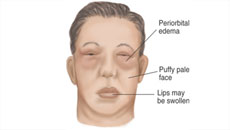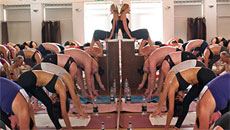How important are routine eye examinations for children? “In my opinion as an eye doctor and a parent I think they are terribly important.”
Consider just 3 simple facts:
• More than 80 per cent of a child’s learning is based on vision!
• One in five children has a vision disorder
• Once in 6 children diagnosed with a learning disability have correctable vision problems
Good vision and eye health are critical to a child’s development. It is up to parents, doctors, nurses, and teachers to ensure that vision disorders if they exist are detected and treated as early as possible. Most children are unable to communicate their problems and can accept their vision disorders as the norm and even learn to compensate for them. Unfortunately, by the time they are seen by a doctor, many serious long term affects already set in. For this reason, most campaigns of awareness call for preschool and kindergarten children to have their eye’s examined and children to be checked each year.
Getting your children examined by an optometrist is different than a school screening. As early as 6 months at our clinics we check infant eyes for eye muscle alignments/strabismus, congenital or birth defects like cataracts, lazy eyes or amblyopia and focusing disorders. By the age of 3 children are usually able to do a full eye exam and have their vision checked on charts that do not require children to know their letters, have their depth perception, color vision along with over-all eye health examined.
Remember, prevention of disorders is the goal in medicine; but if needed early diagnosis and treatment leads to best health outcomes. The eyes are no different. With eye exercises and vision training, many muscle imbalances can be treated, hopefully preventing reading and writing problems and depth perception issues. Lazy eyes can be treated with drops or patching and exercises with best results before the age of 7. If not treated in childhood, the nerve defect lasts forever, resulting in lazy eyes, and can even prevent vision from any further development.
HEALTHY EYES ARE HAPPY EYES!
A Focus on Teens and Active Adults
We get most of our information about the world from our sense of sight. However, many people tend to overlook eye health as part of their regular health routine. Taking care of your eyes doesn’t have to be a cumbersome task. In fact, a simple routine eye exam can detect vision problems, eye disease and some general health problems before you are aware a problem exists. The Canadian Association of Optometrists recommends eye exams at least every year or two, yet most Canadians do not see their eye care professional as often as they should. For people who wear contact lenses, choosing the best product for your eyes is even more important – not all contact lenses are the same. As an eye care professional, I am committed to educating my patients on the best options available for their eyes today.
Choosing The Best Lens For Your Eyes
First, I always tell my patients that a fresh lens is a better lens. One-day replacement contact lenses have been shown to be the healthiest way to wear contact lenses. They lead to reduced complications such as dryness and irritation, fewer unscheduled eye exams, and more satisfaction for you. Your eyes can benefit from UV protection too! Sun exposure is a risk factor for certain types of cataracts and perhaps other eye disorders. Most people don’t realize that you can get UV protection† with certain contact lenses.
Finally, I look for contact lenses that allow an adequate amount of oxygen to permeate the lens. This is important because oxygen will help keep your eyes white and bright. Today there are contact lenses such as the new 1-DAY ACUVUE® TruEye™ Brand Contact Lenses that offer all of these attributes. These are the world’s first contact lenses to combine the health and comfort of HYDRACLEAR® 1 technology with the hygiene and convenience of a single use product. In fact, they were designed, developed and clinically researched to provide exceptional comfort and eye health.
At OmniEye and Vision we pride ourselves on finding contact lens solutions to meet the demands of today’s busy lifestyle. Drop by and visit our dedicated team of eye care professionals at OmniEye and Vision, Burnaby or Port Moody. With today’s vast variety and innovation in contact lens technology, achieving healthy, happy eyes has never been easier.
NEW ADVANCEMENTS IN CARING FORDIABETES EYE DISEASE

Diabetes in the South Asian community is a serious rising concern. It affects multiple body organs and in particular the eyes. Diabetes is the single largest cause of blindness in Canada!
There are 2 disease processes that lead to this blindness:
• There is swelling and fluid accumulation in the retina especially in the area called the macula where the photoreceptors for detailed vision is concentrated – called diabetic macular edema.
• Small blood vessels of the retina in the back of the eye become fragile and leak fluid and blood – this is diabetic retinopathy.
Astonishingly, people with diabetes are more likely to develop cataracts at a younger age and are twice as likely to develop glaucoma also. It is in early detection, diagnosis and management of the disease that eye doctors can assist in preserving vision.
DIABETIC EYE EXAMINATION
Today’s diabetic eye examination has changed from that of the time of our grandparents. It is more than shining a light in the eye, reading the eye chart and writing a prescription for glasses if required. In our clinic for example, the exam for diabetic patients involves the following:
• Discussion of medications, timeline of the diabetes and blood sugar levels. We encourage you to know your A1C (a test of your average blood glucose level over three months). Most people with diabetes should aim for a target of 7.0 or less. Talk to your healthcare team about what your target should be. Uncontrolled blood sugar levels and longer years of having diabetes increase the chances and progression of diabetic eye diseases.
• Routine eye examination, checking the external eye and internal eye structures, eye pressure, prescription for glasses if required.
• Dilated retinal examination – this requires us to instill drops into the eyes to make the pupil wide so that we may use our equipment and head sets to check for diabetic retinopathy.
• Ultrasound-laser/Retinal Imaging. This is probably the greatest advancement in testing that allows for early detection of diabetic retinal disease. We are able to measure and see underneath the retinal vessels and detect blood leakage and fluid accumulation before we can see it with our instruments! This retinal testing is done in the office and is also used to measure the effectively of surgical procedures and future monitoring. The patient and doctor can see these results and discuss them at each visit.
• Visual Field Monitoring – if there are areas of diabetic disease they can cause areas of loss of vision. Doctors monitor the affects of the disease in many ways, but measuring the blind spots that may be created by automated equipment is very effective.
Treatment of diabetic retinopathy has also advanced and continues to evolve. Today along with lasering the retina or other surgical procedures, injections into the eye done in a surgeon’s office may also be a treatment of diabetic retinal disease when caught early enough. The key to maintaining your vision free from diabetic eye disease is good control of blood glucose, cholesterol and high blood pressure levels, and routine examination of the eyes at least annually.
UPDATE ON DRY EYES
(Excerpts taken from Supplement to
Reader’s Digest June 2012)
What Is Dry Eye Disease?
Dry eye disease occurs when the surface of the eye does not get enough tears or the quality of the tears is poor. This results in evaporation of the tears and usually inflammation of the eye’s surface and visual disturbance.
Take the Dry Eye Test!

Stare at each dot for 1 second (e.g. 1 Mississippi, 2 Mississippi, etc.).Count the dots without blinking. If you blinked before the 10th dot or felt eye discomfort you may have Dry Eye.*
*This is based upon the Non-Invasive Break Up Test (NIBUT).The established NIBUT cut-off for Dry Eye diagnosis has been values lying between 5 and < 10 seconds
Interview with Key Opinion Leaders
1. What are the most common myths about Dry Eye Disease?
Dr. Amit Mathur: The most common public myth regarding Dry Eye Disease is that all artificial tears are created equal. Artificial tears vary in their thickness and ability to cause blur on being instilled, and vary in their ingredients. Preservatives in some drops can cause allergy like symptoms or cause stinging, and different drops have differing modes of action and active ingredients.
Once we understand which layer of the tears is the problem causing the dry eye, the proper eye drop can be chosen. Some drops are better for general loss of tear production, while some are better for dryness resulting from loss of tear integrity due to the meibomian glands not secreting the oily component of the tears. Some artificial tears come without preservatives and other eye drops cause blood vessels on the white part of the eye to constrict and take away the redness of the eye, but do nothing to treat the Dry Eye Disease causing the redness itself.
2. What kinds of things should we talk about with our eye care professionals as they relate to Dry Eye Disease?
Dr. Amit Mathur: Awareness of symptoms that can be attributed to Dry Eye Disease is crucial – these commonly are: sensation of burning eyes, a heaviness feeling/tired eyes, stinging, fluctuation in vision, the feeling of gritty or sandy eyes, of foreign body sensation (i.e., having something in the eye), and inability to use contact lenses for long hours.
The signs that the disease may be present are both eyes getting red, usually near day’s end; watering of the eyes spontaneously or when exposed to wind or cold; patients rubbing their eyes a lot; concurrently getting lid redness and sticky lashes and lids on waking; and blocked tear ducts that run along the lid margin. A discussion of these symptoms and signs is definitely a great place to start to determine if Dry Eye Disease is present.
The eye care professional also can really benefit from knowing the general health history of the patient and the medications they may be taking. Contact lens use and solutions that are used by the patients should also be discussed in an eye exam, especially if either the doctor or patient is suspecting Dry Eye Disease.
3. What treatments do you recommend for Dry Eye Disease?
Dr. Amit Mathur: Treating Dry Eye Diseaseis actually complicated and can vary a lot because the underlying causes vary so much – from a person’s internal inability to produce tears, producing poor quality of tears, from being a result of lid diseases and blocked tear ducts, to being exacerbated from medications they take.
The eye care professional should first determine the primary cause of the dry eyes if possible, and then what part of the tears is being affected. Treating blepharitis or lid inflammation with lid scrubs and antibiotic ointment is usually the first step in treatment. Warm compresses (a facecloth held over closed eyelids) and digital massage are effective starting therapies for blocked meibomian glands that may also benefit from oral antibiotics.
Even in minor to moderate Dry Eye Disease, I encourage the use of artificial tears. Once the eye doctor has determined which of the three layers of the tears is problematic, a proper artificial tear supplement drop is chosen. The choice of artificial tear is very important, and will allow for healing of the cornea, replacement of the tear barrier that is absent, and hopefully will limit the inflammation of the eye that results in Dry Eye Disease.
When the inflammation is set in or apparent, an anti-inflammatory steroid eye drop is commonly used, many times in conjunction with the use of artificial tears. In moderate to severe Dry Eye Disease, it is common to advise the use of omega-3 oral supplements that help in the production quality of the tears and have anti-inflammatory properties, and even the use of cyclosporine eye drops to assist in enhancing tear production.

About the Expert
Dr. Amit Mathur, O.D. is co-owner of multi-location optometric practices in British Columbia including those primarily based in ocular health, and participates in Optometric National Advisory Panels for Novartis and Alcon Labs. His research interests include contact lens fitting after corneal surgery, holistic team approaches to systemic diseases, macular degeneration, and ocular surface disease/dry eyes.
NOT ALL LENS COATINGS ARE THE SAME
Each day, our eyeglass lenses are assaulted by numerous “enemies” of clear vision. To truly enjoy the clearest vision possible, our lenses need to maintain free of glare, scratches, smudges, dust, and water. These are the most common culprits that can interfere with the clarity of vision provided by our eyeglass lenses.
Thankfully, there are treatments and coatings that have been developed and can be applied to the surfaces of eyeglass lenses. Experiencing any of the symptoms mentioned above will surely result in loss of productivity and enjoyment of many general, day-to-day tasks.
Eliminating reflections is so crucial in today’s world, as we are constantly bombarded with all kinds of lights from many different sources, natural and artificial, every single day from dawn till dusk. Wearing eyeglass lenses without Anti-Reflective coatings results in visual distraction, poor aesthetics, ghost images, but most importantly… visual discomfort and eyestrain that can cause fatigue.
Anti-reflective coatings have been developed decades ago now, but they refer only to eliminating or decreasing reflections. Today, coatings have evolved – these coatings are not just painted on the surface of a lens, they require a long complicated chemical process.
Only the premium, name branded coatings that are produced by the worlds leaders in the industry are able to provide products that boast 99.2%, and with certain products, 99.6% light transmission. Products such as Crizal EC and Crizal Sapphire UV allow such incredible light transmission and elimination of reflections.
Finally, the last problem that needs to be managed is the day-to-day clean-ability of the lenses.While most eyeglass wearers will clearly understand the benefits of and the need for antireflective coatings, however, many wearers expressed their dissatisfaction, in regards to the day-to-day maintenance required to keep their lenses free from dirt, grime, water and smudges. Eyeglass wearers felt that they needed to clean their lenses far too often and they felt they had to use too much effort, while cleaning.
So, in 2004, major manufacturers developed what are called “easy clean” features to add to their lens coatings. These easy clean components are both oleo-phobic (oil resistant) and hydrophobic (water resistant). This has virtually eliminated any consumer concern of “clean-ability” issues. While some “generic” lenses as well as most branded lenses both provide the easy clean feature, branded lenses offer top quality performance and are tangibly more “smoother” and more “slippery” than their generic counterparts.





